Key Takeaways
- The Postal Service Health Benefits (PSHB) program, starting January 2025, brings significant changes to health coverage for USPS workers, requiring careful attention to enrollment periods and plan selection.
- Understanding the transition to PSHB and its impact on existing health benefits is essential for all USPS employees and retirees to ensure continuous coverage.
Family Health Benefits Under PSHB: What Every USPS Worker Needs to Know About the Changes
The transition to the Postal Service Health Benefits (PSHB) program marks a major shift in health coverage for employees of the United States Postal Service (USPS). This new program, which will go into effect on January 1, 2025, is designed to align USPS employees and retirees with the broader Federal Employees Health Benefits (FEHB) program while addressing the unique needs of postal workers. Understanding the upcoming changes and how they impact family health benefits is crucial for ensuring continuous and appropriate coverage.
The Transition to PSHB: What’s Changing?
As part of the 2022 Postal Service Reform Act, the PSHB program was established to provide health insurance coverage exclusively for USPS employees, retirees, and their eligible family members. This program will operate alongside the FEHB, but with certain modifications tailored to the postal workforce. The transition to PSHB is a mandatory change, meaning that all USPS employees and retirees currently enrolled in FEHB will need to transition to a PSHB plan during the upcoming enrollment period.
Key Dates and Enrollment Deadlines
The enrollment period for PSHB is expected to take place in late 2024, ahead of the January 2025 start date. It is vital for USPS employees and retirees to be aware of this enrollment period as it represents the only opportunity to choose a PSHB plan for 2025 without a qualifying life event. Missing the enrollment window could result in a lapse in coverage or being defaulted into a plan that may not best meet the needs of your family.
Coverage Continuity: What Happens to Existing FEHB Plans?
One of the primary concerns for USPS workers is the continuity of coverage as they transition from FEHB to PSHB. Fortunately, there are provisions in place to ensure that no employee or retiree loses coverage during the switch. However, it is important to note that while the PSHB will offer plans similar to those under the FEHB, there will be differences in premiums, provider networks, and coverage options. Employees should carefully review their options during the enrollment period to select the plan that best suits their family’s needs.
Family Coverage Under PSHB: What to Expect
Family coverage under the PSHB program will mirror the structure of FEHB in many ways, but with certain nuances that USPS workers need to be aware of. The PSHB will offer self-only, self-plus-one, and self-and-family coverage options, just like the FEHB. However, the cost-sharing structure and the specific benefits offered may differ depending on the plan chosen.
Eligibility and Enrollment for Family Members
All eligible family members currently covered under an employee’s or retiree’s FEHB plan will be eligible for PSHB coverage. This includes spouses, children under 26, and in some cases, dependent children over 26 who meet certain criteria. It’s important to review the eligibility requirements and ensure that all family members who need coverage are properly enrolled during the PSHB open season. Failure to do so could result in losing coverage for a family member until the next open enrollment period.
Premiums and Cost-Sharing
While exact premiums for PSHB plans will not be finalized until closer to the enrollment period, USPS employees should anticipate potential changes in the cost-sharing structure. Premiums under PSHB are expected to be competitive with those in the FEHB, but there could be variations based on the specific plan and region. Additionally, out-of-pocket costs such as deductibles, copayments, and coinsurance may differ from current FEHB plans, making it essential to compare options carefully.
Impact on Retirees: What You Need to Know
Retirees and their families will also be affected by the shift to PSHB, particularly those who are currently enrolled in Medicare. Under the new program, retirees who are eligible for Medicare will be required to enroll in both Medicare Part A and Part B to maintain their PSHB coverage. This requirement is a significant change from the current FEHB structure, where enrollment in Medicare Part B is optional but often encouraged.
Medicare Integration
The integration of Medicare with PSHB is designed to streamline healthcare coverage for retirees while potentially reducing overall costs. Retirees who are enrolled in Medicare Parts A and B will see their PSHB plan act as a secondary payer, which could result in lower out-of-pocket costs. However, retirees should carefully evaluate the benefits and premiums associated with enrolling in Medicare Part B, as it does involve an additional monthly premium.
Special Considerations for Retirees Without Medicare
Retirees who are not yet eligible for Medicare, or who choose not to enroll in Medicare Part B, will still have access to PSHB coverage. However, the cost and benefits of these plans may be less favorable compared to those available to retirees with Medicare. As such, it is recommended that retirees approaching age 65 consider the financial implications of enrolling in Medicare Part B to maximize their benefits under the PSHB.
How to Prepare for the Upcoming Changes
With the January 2025 transition date approaching, it is crucial for USPS employees and retirees to begin preparing for the switch to PSHB. Here are some steps to take to ensure a smooth transition:
Review Current Coverage and Health Needs
Start by reviewing your current FEHB coverage and assessing your family’s healthcare needs. Consider factors such as the types of medical services you regularly use, preferred healthcare providers, and any ongoing medical conditions that may require specialized care. This will help you identify the PSHB plans that offer the best match for your needs.
Attend Information Sessions and Utilize Resources
USPS will likely offer informational sessions, webinars, and other resources to help employees understand the new PSHB program. Take advantage of these opportunities to ask questions and gather detailed information about plan options, coverage differences, and the enrollment process. Additionally, reviewing the Office of Personnel Management (OPM) website, which will manage the PSHB program, can provide valuable insights.
Plan for the Enrollment Period
Mark your calendar for the upcoming enrollment period in late 2024. Given the importance of this enrollment window, plan to review your options as early as possible. Consider seeking guidance from a licensed insurance agent who can help you navigate the choices and ensure that you select the best plan for your family’s needs.
Consider the Long-Term Implications
The switch to PSHB is not just a short-term change; it will impact your healthcare coverage for years to come. As you evaluate your options, think about your family’s long-term health needs and how the plan you choose will support those needs over time. For retirees, this may also involve considering the timing of Medicare enrollment and how it integrates with PSHB coverage.
Ensuring Seamless Coverage: Final Thoughts
The upcoming transition to the Postal Service Health Benefits program represents a significant change for USPS workers and retirees. By understanding the changes, carefully reviewing plan options, and preparing for the enrollment period, you can ensure that your family’s health coverage remains robust and uninterrupted. Whether you are a current USPS employee or a retiree, taking proactive steps now will help you navigate the transition smoothly and maintain peace of mind regarding your healthcare.
Contact Information:
Email: [email protected]
Phone: 5105558901







